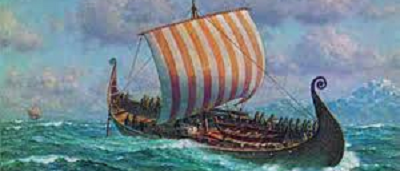Viking Longships
Posted on 28th December 2020
When we think about Vikings, it is the longship or dragonship that enters our mind. These ships were a highly valued possession and the Vikings naval force.
Longships were made from wood with oak being the preferred choice. Wooden planks were placed overlapping each other, then riveted together to keep them in place. This was called the ‘Clinker’ method; any gaps in the wood were filled with tarred wool or animal hair.
Oars were placed along the entire length of the vessel and it was given a bright, highly decorated square sail.
Viking ships had many ornate carvings on them. and a large dragon or snakes head at the end of the long curving neck. This was to ward off evil spirits and sea monsters and is where they got the name dragonship.
Longships were built for speed. They were long and narrow and built with a flat-bottomed hull, making them easier to use in shallow water and good for beach landings. They also built deeper longships for carrying cargo and livestock.
The sail could be removed from the ship and fitted to the side like a tent to protect the crew, also on land the boat could be turned upside down and used as shelter.
There are different types of longships including:
Snekkja - A longship used for both pleasure and warfare. It was the smallest longship used in warfare and could hold about forty crew, twenty oarsmen on each side, also with another person to use the rudder and steer. These were light in weight and could be easily carried.
Skied - The longest Viking longship with about thirty oarsmen on each side.
The Snekkja and Skied did not have benches for the oarsmen to sit on. They sat on sea chests that held supplies.
Knarr - Cargo supply ships that were heavier and shorter in length, with a deeper hull. They could carry up to forty tonnes of supplies and livestock. When returning from raids they also carried the pillaged items taken during these raids.
Tagged as: Junior The Vikings
Share this post:





